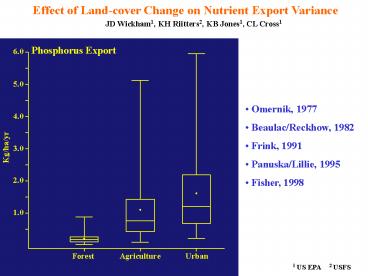Phosphorus Export - PowerPoint PPT Presentation
1 / 12
Title:
Phosphorus Export
Description:
JD Wickham1, KH Riitters2, KB Jones1, CL Cross1 Phosphorus Export 6.0 5.0 Omernik, 1977 Beaulac/Reckhow, 1982 Frink, 1991 Panuska/Lillie, 1995 Fisher, 1998 – PowerPoint PPT presentation
Number of Views:87
Avg rating:3.0/5.0
Title: Phosphorus Export
1
Effect of Land-cover Change on Nutrient Export
Variance
JD Wickham1, KH Riitters2, KB Jones1, CL Cross1
Phosphorus Export
6.0
5.0
- Omernik, 1977
- Beaulac/Reckhow, 1982
- Frink, 1991
- Panuska/Lillie, 1995
- Fisher, 1998
4.0
Kg/ha/yr
3.0
2.0
1.0
Forest
Agriculture
Urban
1 US EPA
2 USFS
2
Impacts of Excessive Nutrients on Water Bodies
- Aquatic Life Support
- Low DO
- Reduced light penetration
- Nuisance/toxic algae blooms
- Drinking Water
- Taste and order issues
- Clogging water intake systems
- nuisance algae
- Health issues (high nitrites)
- Recreation
- Reduced water clarity
- Negative effect on real estate values
- (U. of Maine, 1996)
Cladophora glomerata
3
-- Methods --
Estimating the effect of land-cover change on N
P export variance
- Compile proportions of forest, agriculture, and
urban by 14-digit watersheds for eastern
two-thirds of Maryland using 1992 and 2001
land-cover data (NLCD). - Run N and P export simulations models (by
watershed) on 1992 and 2001 land-cover data
(estimate mean variance 1000 obs/ws/date). - Repeat simulations 150 times (per watershed, per
date) to generate confidence intervals for means
and variances). - Compare confidence intervals significance
declared when there was a positive difference (a
gap) between mean and variance ranges over time.
1992
2001
Ws 1
Ws 2
4
Changes in Nitrogen Export Distribution by
Watershed
- 143 of 812 watersheds had significant increases
in export mean variance. - Average percentage forest loss was 11 for
watersheds with significant increase in variance. - Percentage forest loss was not constant amount
of forest loss required to significantly change
variance increased as percentage forest decreased.
2001 Proportion Forest
5
Changes in Phosphorus Export Distribution by
Watershed
- 140 of 812 watersheds had significant increases
in export variance. - Average percentage forest loss was 12 for
watersheds with significant increase in variance. - Percentage forest loss was not constant amount
of forest loss required to significantly change
variance increased as percentage forest decreased.
2001 Proportion Forest
6
Why Is Variance Important?
Date Precipitation (cm/yr) N export (kg/ha/yr) P export (kg/ha/yr)
1981 102 3.21 0.23
1982 102 5.06 0.19
1983 129 8.17 0.42
1984 141 11.50 0.49
1985 109 2.89 0.14
1986 77 5.09 0.15
1987 100 5.77 0.20
1988 96 3.30 0.35
1989 149 9.44 0.65
1990 116 7.42 0.23
Upper Choptank, MD 49 agriculture 49 forest 1
urban
Fisher et al. 1998. Linker et al. 1996
USGS gauging station 01491000
An increase in variance is an increase in
sensitivity to outside factors outside factors
are more difficult to control, making
environmental management more difficult.
7
Restoration?
Nutrient Source Management BMPs Structural BMPs Vegetative BMPs
Agriculture Nutrient mgt. Livestock-to-land ratio Range mgt. Waste composting Irrigation mgt. Lagoon mgt. Crop residue mgt. Livestock waste mgt. Animal waste sys. Fences Diversions Terraces Tailwater pit Detention ponds Constructed wetland Stream bank stabilization Crop cover Strip cropping Riparian buffer Crop types (N/P needs) Conservation tillage Vegetated filter strips Critical area planning
Urban Zoning ordinances Restrictive covenants Growth mgt. Buffers setbacks Site plan review Permitting pollutant disch. Public education Pollution prevention pgs. Spill control programs Road maintenance pgs. Septic pump-out schedule Extended detention ponds Constructed wetland Multiple pond systems Infiltration trenches Vegetated filter strips Riparian buffer Vegetative cover
Source US EPA 1999. Protocol for developing
Nutrient TMDLs. EPA 841-B-99-007
8
Riparian Buffers?
- Ability of riparian vegetation to remove
nutrients depends on the relative depths of
rooting zone and shallow groundwater (Lowrance et
al. 1997. Env. Mgt.) - Riparian buffers can be sources (instead of
sinks) of P on a seasonal basis (Osborne and
Kovacic, Fr. Bio. 1993). - Riparian buffers are not as effective in
agricultural areas with tile drainage (Osborne
and Kovacic, Fr. Bio. 1993). - Riparian buffers are less effective at removing
P (than N) (Lowrance et al. Env. Mgt., 1997). - Entire watershed gives better R2 than near
stream (Hunsaker/Levine, Bioscience, 1995). - Entire watershed (Omernik, 1981)
Min Max N 2.89 11.50 P 0.15 0.65
Four-fold change in annual N/P export despite
well-developed riparian network
9
Multiple Detention Ponds?
10
Site Plan Review?
High Impact Development
Low Impact Development
Runoff flow
Residential bioretention system -- focused
retention and infiltration
11
Growth Management?
TN (kg/ha/yr)
Construction-I 8.3
Construction-II 36.3
Line et al. 2003, Water. Env. Res.
12
A Future Conclusion 5053 miles of Maryland
streams/shorlines are identified as impaired due
to nutrients (epa.gov/owow/tmdl/303dcaus.html). I
n the face of land-cover change, what is your
guess for the number miles of nutrient-related
impairments in 2020?
A Present Conclusion The future is upon us
what should the plan be?
Urban
Urban
Forest
Forest
Agriculture
Agriculture
1992
2001































